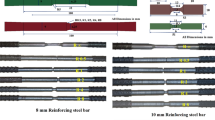Abstract
Cold-formed steel structures are steel structure products constructed from sheets or coils using cold rolling, press brake or bending brake method. These structures are extensively employed in building construction industry due to their light mass, ductility by economic cold forming operations, favorable strength-to-mass ratio and other factors. The utilization of cold formed steel sections with concrete as composite can hugely reduce the construction cost. However, the use of cold formed steel members in composite concrete beams has been very limited. A comprehensive review of developments in composite beam with cold formed steel sections was introduced. It was revealed that employing cold-formed steel channel section to replace reinforcement bars in conventional reinforced concrete beam results in a significant cost reduction without reducing strength capacity. The use of composite beam consisting of cold-formed steel open or close box and filled concrete could also reduce construction cost. Lighter composite girder for bridges with cold-formed steel of U section was introduced. Moreover, types of shear connectors to provide composite action between cold-formed steel beam and concrete slab were presented. However, further studies to investigate the effects of metal decking on the behavior of composite beam with cold-formed steel section and introduction of ductile shear connectors were recommended.
Similar content being viewed by others
References
SCHAFER B W. Cold-formed steel structures around the world [J]. Ernst and Sohn, Steel Construction, 2001, 4(3): 141–149.
MACDONALD M, HEIYANTUDUWA M A, RHODES J. Recent developments in the design of cold-formed steel members and structures [J]. Thin-Walled Structures, 2008, 46(7/8/9): 1047–1053.
YU W W. Cold-formed steel design [M]. New York: John Wiley and Sons Inc. 2000
HANCOCK G, MURRAY T, ELLIFRITT D. Cold-formed steel structures to the AISI Specification [M]. New York: Marcel Dekker Inc. 2001.
ALLEN D. Mid-rise construction detailing issues with cold-formed steel and compatible construction materials [J]. Structures Congress, 2006: 1–10.
NGUYEN R. Thin-walled, cold-formed steel composite beams [J]. Journal of Structural Engineering, 1991, 117(10): 2936–2952.
HOSSAIN A. Designing thin-walled composite-filled beams [J]. Proceedings of the Institution of Civil Engineers, Structures & Buildings, 2005, 158(SB4): 267–278.
HOSSAIN A. Experimental & theoretical behavior of thin walled composite filled beams [J]. Electronic Journal of Structural Engineering, 2003, 3(3): 117–139.
ABDULLAH R, TAHIR M, OSMAN M. Performance of cold-formed steel of box-section as composite beam [C]// 6th International Conference on Steel and Space Structures, Singapore: ICSSS, 1999, 2–3.
BS5950. Structural use of steelwork in building Part 1: Code of practice for design in simple and continuous construction: Hot rolled sections [S].
NAKAMURA S. Bending behavior of composite girders with cold formed steel u section [J]. Journal of Structural Engineering. 2002, 128(9): 1169–1176.
WEHBE N, WEHBE A, DAYTON L, SIGL A. Development of concrete/cold formed steel composite flexural members [J]. Structures Congress, 2011: 3099-3109.
HANAOR A. Tests of composite beams with cold-formed sections [J]. Journal of Constructional Steel Research, 2000, 54(2): 245–264.
LAKKAVALLI B, LIU, Y. Experimental study of composite cold-formed steel C-section floor joists [J]. Journal of Constructional Steel Research, 2006, 62(10): 995–1006.
IRWAN M, HANIZAH A, AZMI I, BAMBANG P, KOH H, ARUAN M. Shear transfer enhancement in precast cold-formed steel-concrete composite beams: Effect of bent-up tabs types and angles [C]// Technology and Innovation for Sustainable Development Conference, Thailand: TISD, 2008: 56–61.
IRWAN M, HANIZAH A, AZMI I. Test of shear transfer enhancement in symmetric cold-formed steel concrete composite beams [J]. Journal of Constructional Steel Research, 2009, 65(12): 2087–2098.
IRWAN M, HANIZAH A, AZMI I, KOH H. Large-scale test of symmetric cold-formed steel (CFS)-concrete composite beams with BTTST enhancement [J]. Journal of Constructional Steel Research. 2011, 67(4): 720–726.
Author information
Authors and Affiliations
Corresponding author
Rights and permissions
About this article
Cite this article
Bamaga, S.O., Tahir, M.M., Tan, T.C. et al. Feasibility of developing composite action between concrete and cold-formed steel beam. J. Cent. South Univ. 20, 3689–3696 (2013). https://doi.org/10.1007/s11771-013-1897-9
Received:
Accepted:
Published:
Issue Date:
DOI: https://doi.org/10.1007/s11771-013-1897-9




